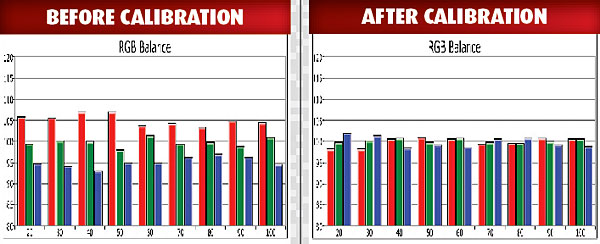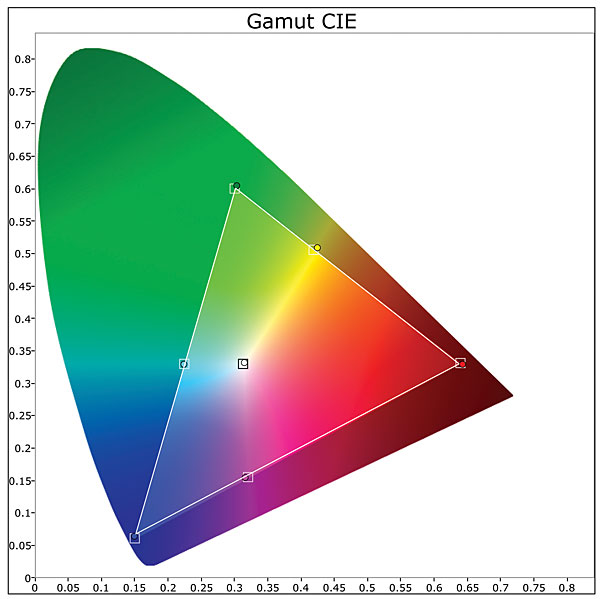Samsung PN60F8500 3D Plasma HDTV HT Labs Measures
Full-On/Full-Off Contrast Ratio: 18,729:1
All the 2D measurements here were taken in the Movie mode. The Cell Light was set to 17, Contrast to 89, Brightness to 50, Dynamic Contrast to Low, Color Tone to Warm 2, and Gamma to –1.
The full-on/full-off contrast ratio above was calculated at the settings indicated from a measured peak white level of 31.84 foot-lamberts and a full black field reading of 0.0017 ft-L. Higher Cell Light settings can produce a brighter picture. But I found that setting this control to 14 or 15 in normal, evening room lighting (13 for movies in a darkened or near-dark room) produced the most comfortable 2D viewing, as long as the room lighting does not bounce directly off the set’s reflective screen.

Color-tracking charts were generated in SpectraCal CalMAN, www.SpectraCal.com
The RGB Balance charts show how well a display adheres to the D65 standard white point; the tighter the match of the three primary colors, the nearer the result is to D65 at each point in the brightness range. Delta E is a figure of merit showing how close the result is to this standard D65 white point. Most experts recommend a Delta E value of 4 or less, though some recommend a Delta E of no more than 3 for a visibly ideal result.
Pre-calibration in the Warm 2 Color Tone (color temperature) setting, the gray-scale Delta E averaged 3.61 (3.08 to 4.48 from 40 percent to 90 percent, min 1.28 at 20 percent, max 6.61 at 100 percent). Post-calibration, using only the two-point calibration controls, the Delta E averaged 0.82, with a maximum of 1.49 at 100 percent. The gamma averaged 2.2 (low 2.1 at 80 percent, high 2.31 at 90 percent) in the –1 setting of the Gamma control.
The CIE chart shows the postcalibration color gamut, which closely matches the Rec. 709 standard. In the Auto setting of the Color Space control, the average 2D color Delta E was 1.4.

In 3D, prior to calibration, the grayscale Delta E averaged 10.88. This falls just over the “clearly visible but not necessarily objectionable to all viewers” Delta E range (5 to 10). The main deviation was excessive red at all points. Those who choose not to have a 3D calibration performed might find that a different setting of the Color Tone control, Warm 1 or even Standard, is a better choice for 3D than Warm 2. After calibration, the gray-scale Delta E averaged 3.08 (under 3.94 from 30 percent to 90 percent and a maximum of 7.0 and plus blue at 20 percent). For 3D, I chose the Custom Color Space setting and adjusted the controls to improve the average 3D color Delta E from 5.09 (Auto, pre-calibration) to 1.37 (Custom, post-calibration).

With a Gamma control setting of –3, the 3D gamma measured an average of 1.28! More significant, perhaps to the 3D saturation instability mentioned in the review, the 3D gamma averaged 1.48 from 20 percent to 60 percent but dropped to an average of 0.95 (!) from 70 percent to 90 percent. But because of a unique characteristic of plasma HDTVs—they gradually reduce screen brightness as the source level increases because of real-world power supply limitations—measuring gamma in either 3D or 2D using normal procedures can be iffy.—TJN













































